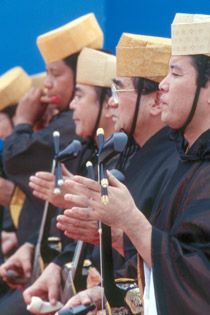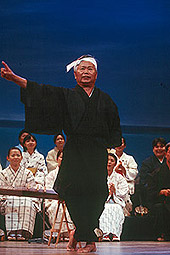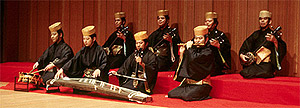The sanshin three-stringed instrument is said to have come to Okinawa from China toward the end of the 14th century, during the reign of the Ryukyuan King Satto. Subsequently it spread as a precious instrument used in performances by members of the nobility. Especially as an instrument to accompany songs, the sanshin became an exclusive and refined hobby for members of the upper and noble classes well versed in Okinawan omoro poetry and song. In the sixteenth century, something of a sanshin boom developed and the sanshin spread to mainland Japan. By the end of the seventeenth century, courtesans who laid down the foundations of Okinawan sanshin music had taken it up, according to Tansui master Kochi Kenchu. Tamagusuku Chokun reports that by the early 18th century, when the kumi-odori was first performed for Chinese imperial envoys, the sanshin had become an indispensable part of ukwanshin (Chinese emissary ship) dances.
The musicians in traditional Ryukyuan dance, called jiutee, accompany singers on sanshin, koto, flute, Chinese fiddle, drum and other instruments. When dancers, singers and jiutee first became one, something wonderful was born. Nothing could be more lavish and enthralling than a live performance of Ryukyuan dance.



